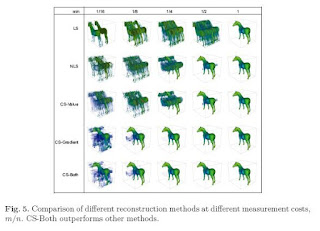 Here is a new use of structured illumination (see also here for the Rice set up and here for the Arizona set up) to uncover 3D information ( see also yesterday's Compressive sensing for background subtraction) in participating media. In previous hardware implementation, we really were dealing with non participating media, i.e. light gets to bounce on surfaces. In this new paper, it is like in neutron transport where one is solving the simple case of absorption and single scattering only. The big target is really for multiple scattering as it clearly has a big potential for light transmission through turbid media like the skin.
Here is a new use of structured illumination (see also here for the Rice set up and here for the Arizona set up) to uncover 3D information ( see also yesterday's Compressive sensing for background subtraction) in participating media. In previous hardware implementation, we really were dealing with non participating media, i.e. light gets to bounce on surfaces. In this new paper, it is like in neutron transport where one is solving the simple case of absorption and single scattering only. The big target is really for multiple scattering as it clearly has a big potential for light transmission through turbid media like the skin.Compressive Structured Light for Recovering Inhomogeneous Participating Media by Jinwei Gu, Shree Nayar, Eitan Grinspun, Peter Belhumeur, and Ravi Ramamoorthi. The abstract reads:
We propose a new method named compressive structured light for recovering inhomogeneous participating media. Whereas conventional structured light methods emit coded light patterns onto the surface of an opaque object to establish correspondence for triangulation, compressive structured light projects patterns into a volume of participating medium to produce images which are integral measurements of the volume density along the line of sight. For a typical participating medium encountered in the real world, the integral nature of the acquired images enables the use of compressive sensing techniques that can recover the entire volume density from only a few measurements. This makes the acquisition process more efficient and enables reconstruction of dynamic volumetric phenomena. Moreover, our method requires the projection of multiplexed coded illumination, which has the added advantage of increasing the signal-to-noise ratio of the acquisition. Finally, we propose an iterative algorithm to correct for the attenuation of the participating medium during the reconstruction process. We show the effectiveness of our method with simulations as well as experiments on the volumetric recovery of multiple translucent layers, 3D point clouds etched in glass, and the dynamic process of milk drops dissolving in water.
A 25MB video on the results of the paper can be found here.
No comments:
Post a Comment